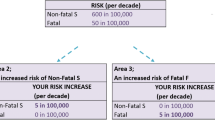Abstract
We report the results of two stated-preference surveys (one conducted using face-to-face interviews, the other via the internet) which examined how the values people place on preventing fatalities from rail accidents are affected by the extent to which victims are responsible for their death, and the scale of the accident. The results showed that respondents placed a premium on preventing deaths which involved a failure of the rail system, rather than the irresponsible behaviour of an adult victim, though this differential was less marked when the person behaving irresponsibly was a child, rather than an adult. However, the prevention of a death in a multiple-fatality accident was not accorded a significantly higher value than the prevention of death in the single-fatality case. As far as the overall results are concerned, there was an encouragingly close correspondence between the findings of the face-to-face and internet surveys.


Similar content being viewed by others
References
Baron, J. & Ubel, P. A. (2002). Types of inconsistency in health-state utility judgments. Organisational Behavior and Human Decision Processes, 89, 1100–1118.
Chilton, S., Covey, J., Hopkins, L., Jones-Lee, M. W., Loomes, G., Pidgeon, N., et al. (2002). Public perceptions of risk and preference-based values of safety. Journal of Risk and Uncertainty, 25(3), 211–232.
Chilton, S., Jones-Lee, M., Kiraly, F., Metcalf, H., & Pang, W. (2006). Dread risks. Journal of Risk and Uncertainty, 33, 165–182.
Damschroder, L. J., Roberts, T. R., Zikmund-Fisher, B. J., & Ubel, P. A. (2007). Why people refuse to make tradeoffs in person trade off elicitations: A matter of perspective? Medical Decision Making, 27, 266–280.
Dolan, P., Cookson, R., & Ferguson, B. (1999). Effect of discussion and deliberation on the public’s views of priority setting in health care: Focus group study. British Medical Journal, 318, 916–919.
Drèze, J. H. (1962). L’utilité sociale d’une vie humaine. Revue Française de Recherche Operationelle, 22, 139–155.
Evans, A. (2006). Written evidence presented to House of Lords Select Committee Inquiry into Government Policy on the Management of Risk. London, The Stationery Office. Vol II: Evidence, 130–137.
Furnham, A., Simmons, K., & McClelland, A. (2000). Decisions concerning the allocation of scarce medical resources. Journal of Social Behavior and Personality, 15(2), 185–200.
Horlick-Jones, T. (2008). Reasoning about safety management policy in everyday terms: A pilot study in citizen engagement for the UK railway industry. Journal of Risk Research, 11(6), 697–718.
Johansson-Stenman, O. & Martinsson, P. (2008). Are some lives more valuable? An ethical preferences approach. Journal of Health Economics, 27(3), 739–752.
Jones-Lee, M. W. (1974). The value of changes in the probability of death or injury. Journal of Political Economy, 82, 835–849.
Jones-Lee, M. W. (1976). The value of life: An economic analysis. Chicago: University of Chicago Press.
Jones-Lee, M. W. & Loomes, G. (1995). Scale and context effects in the valuation of transport safety. Journal of Risk and Uncertainty, 11(3), 183–203.
Loewenstein, G., & O’Donoghue, T. (2004), Animal spirits: Affective and deliberative processes in economic behaviour. Cornell University, Center for Analytic Economics Working Paper #04–14. Available online at http://www.arts.cornell.edu/econ/CAE/04-14.pdf
Lords Hansard. (June 2003, Columns 271, 271). House of Lords Debates available online at http://www.publications.parliament.uk/pa/ld200203/ldhansrd/vo030605/text/30605-41.htm#30605-41_spnew7
NICE — National Institute for Health and Clinical Excellence. (2008). Social Value Judgments: Principles for the Development of NICE Guidance. Second Edition. Available online at http://www.nice.org.uk/media/C18/30/SVJ2PUBLICATION2008.pdf
Nord, E. (1995). The person trade-off approach to valuing health care programs. Medical Decision Making, 15(3), 201–208.
Robinson, A., Covey, J., Spencer, A., & Loomes, G. (2007) Are some deaths worse than others? Results from a Discrete Choice Experiment. Queen Mary University Working paper number 597. Available online at http://www.econ.qmul.ac.uk/papers/doc/wp597.pdf
Schelling, T. C. (1968). The life you save may be your own. In S. B. Chase (Ed.), Problems in Public Expenditure Analysis. Washington: Brookings.
Schwappach, D.L.B. (2002). The equivalence of numbers: The social value of avoiding health decline: An experimental web-based survey. BMC Medical Informatics and Decision Making, 2(3).
Slovic, P. (1987). The perception of risk. Science, 36, 280–285.
Slovic, P., Finucane, M. L., Peters, E., & MacGregor, D. G. (2007). The affect heuristic. European Journal of Operational Research, 177(3), 1333–1352.
Subramanian, U. & Cropper, M. (2000). Public choices between life saving programs: The tradeoff between qualitative factors and lives saved. Journal of Risk and Uncertainty, 21(1), 117–149.
Viscusi, W. K. (1978). Labor market valuations of life and limb: Empirical evidence and policy implications. Public Policy, 26, 359–386.
Viscusi, W. K. (2009). Valuing risks of death from terrorism and natural disasters. Journal of Risk and Uncertainty, 38(3), 191–213.
Viscusi, W. K., Magat, W. A., & Huber, J. (1991). Pricing environmental health risks: Survey assessment of risk-risk and risk-dollar tradeoffs for chronic bronchitis. Journal of Environmental Economics and Management, 21, 32–51.
Acknowledgements
The study conducted in this paper was commissioned by the Rail Safety and Standards Board (RSSB), on behalf of the British rail industry as part of its research and development program, which is funded by the UK government through the Department for Transport. The authors would like to thank Terry Thomson (Oxford Risk) for his management of this project, Andy Morris (GfK NOP) and Tim Sykes (YouGov) for overseeing the programming and interface design for the CAPI and internet surveys. We are also grateful to members of RSSB for insightful comments and suggestions during the research. However the opinions expressed in the paper are those of the authors and are not necessarily shared by RSSB or others associated with the project. In addition, we thank the editor for many very helpful comments and suggestions.
Author information
Authors and Affiliations
Corresponding author
Rights and permissions
About this article
Cite this article
Covey, J., Robinson, A., Jones-Lee, M. et al. Responsibility, scale and the valuation of rail safety. J Risk Uncertain 40, 85–108 (2010). https://doi.org/10.1007/s11166-009-9082-0
Published:
Issue Date:
DOI: https://doi.org/10.1007/s11166-009-9082-0




